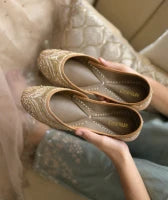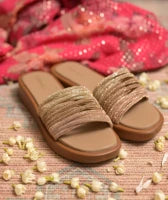
How to Clean Kolhapuri Chappal: A Comprehensive Guide
Share
Embracing the Art of Cleaning Kolhapuri Chappal
Kolhapuri chappals, with their unique design and rich history, are a cherished symbol of Indian heritage. These handcrafted leather sandals have been worn by generations, passed down for their comfort and elegance. However, with frequent use, they can accumulate dirt, stains, and odors. To preserve the beauty and extend the life of your Kolhapuri chappals, it's essential to clean them regularly. In this comprehensive guide, we will explore the best practices for cleaning Kolhapuri chappals, ensuring they remain a timeless part of your wardrobe.
1. Understanding the Construction of Kolhapuri Chappal
Before we dive into the cleaning process, let's gain a deeper understanding of how Kolhapuri chappals are made. These handcrafted sandals are traditionally crafted by skilled artisans using high-quality leather and intricate weaving techniques. The chappals consist of two main parts: the sole and the upper.
1.1 The Sole: Durable and Comfortable Foundation
The sole of Kolhapuri chappal is usually made from layers of leather, providing flexibility, durability, and a comfortable walking experience. The sturdy sole also protects the feet from uneven surfaces and sharp objects.
1.2 The Upper: Artistic Embellishments
The upper part of the Kolhapuri chappal features beautiful designs and patterns created through the art of hand weaving. The leather straps are carefully crafted to ensure a snug fit and aesthetic appeal.
2. Pre-Cleaning Preparations
Before initiating the cleaning process, gather the necessary materials and prepare the chappals for cleaning.
2.1 Materials Needed
- Soft-bristled brush or toothbrush
- Mild soap or leather cleaner
- Warm water
- Soft cloth or sponge
- Old newspapers or dry cloth for drying
2.2 Removing Surface Debris
To begin, gently tap the chappals together to remove loose dirt and debris. Then, use a soft-bristled brush or toothbrush to brush away any remaining dirt from the soles and the upper. Be gentle to avoid damaging the delicate handwoven patterns.
3. Cleaning Kolhapuri Chappal Step by Step
Now that your chappals are prepared, it's time to clean them thoroughly. Follow these step-by-step instructions for the best results.
3.1 Creating a Cleaning Solution
In a small bowl, mix a few drops of mild soap or leather cleaner with warm water. Avoid using harsh chemicals or excessive water, as they may damage the leather or affect the colors.
3.2 Cleaning the Soles
Dip the soft cloth or sponge into the cleaning solution and wring out any excess water. Gently wipe the soles of the chappals to remove dirt and stains. Focus on the areas with visible grime or buildup.
3.3 Cleaning the Upper
For the upper part, use the same cleaning solution and cloth or sponge to clean the leather straps. Pay extra attention to the handwoven patterns, ensuring they remain intact.
3.4 Removing Stubborn Stains
If there are stubborn stains that the regular cleaning solution couldn't remove, make a paste using baking soda and water. Apply the paste to the stains, leave it for a few minutes, and then gently scrub with a soft brush. Wipe off the paste with a damp cloth.
3.5 Drying the Chappals
Place the cleaned chappals on old newspapers or a dry cloth to air dry. Avoid exposing them to direct sunlight or using a heater, as excessive heat can damage the leather.
4. Tips to Maintain Kolhapuri Chappal
Now that your Kolhapuri chappals are clean, follow these tips to maintain their beauty and prolong their lifespan.
4.1 Store Properly
When not in use, keep your chappals in a cool, dry place away from direct sunlight and moisture. Consider using shoe bags or fabric pouches to protect them from dust.
4.2 Regular Cleaning
Make cleaning your chappals a regular practice, especially after wearing them outdoors. This will prevent dirt and sweat from accumulating, making the cleaning process easier.
4.3 Leather Conditioning
Every few months, apply a small amount of leather conditioner to keep the leather soft and moisturized. This will prevent it from drying out and cracking.
4.4 Avoid Water Exposure
While Kolhapuri chappals can withstand light rain, avoid wearing them in heavy downpours or submerging them in water. Excessive water exposure can lead to discoloration and damage.
4.5 Professional Cleaning
If you are unsure about cleaning the chappals yourself or dealing with tough stains, consider taking them to a professional shoe cleaner with experience in handling delicate leather footwear.
How to Clean Kolhapuri Chappal? Frequently Asked Questions (FAQs)
Q: Can I wash Kolhapuri chappals in a washing machine?
A: No, it's not recommended to wash Kolhapuri chappals in a washing machine. The machine's agitator and excessive water can damage the delicate leather and handwoven patterns.
Q: Can I use bleach to remove stains from my chappals?
A: No, bleach should not be used on Kolhapuri chappals as it can cause discoloration and weaken the leather.
Q: How do I get rid of bad odors from my chappals?
A: To eliminate odors, sprinkle baking soda inside the chappals and let it sit overnight. Shake off the excess baking soda the next day.
Q: Can I wear my chappals immediately after cleaning?
A: It's best to allow the chappals to air dry completely before wearing them again to avoid potential damage.
Q: Are Kolhapuri chappals suitable for formal occasions?
A: Yes, depending on the design and embellishments, some Kolhapuri chappals can be worn for semi-formal or festive events.
Q: How long do Kolhapuri chappals usually last?
A: With proper care and maintenance, Kolhapuri chappals can last for several years.
Summary: A Timeless Tradition of Care and Craftsmanship
Cleaning Kolhapuri chappals is a simple yet vital process to maintain their charm and durability. By following the proper cleaning techniques and adopting good maintenance practices, you can ensure that your beloved Kolhapuri chappals continue to be a symbol of Indian heritage and a timeless addition to your footwear collection.
Already a fan of this classic style or looking to add another to your wardrobe? Browse our Kolhapuri chappal collection for new designs handcrafted with the same tradition and care.





